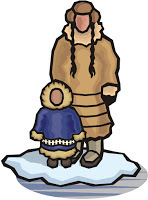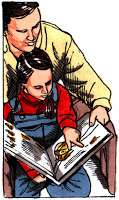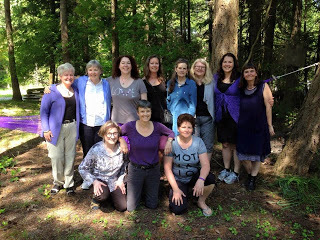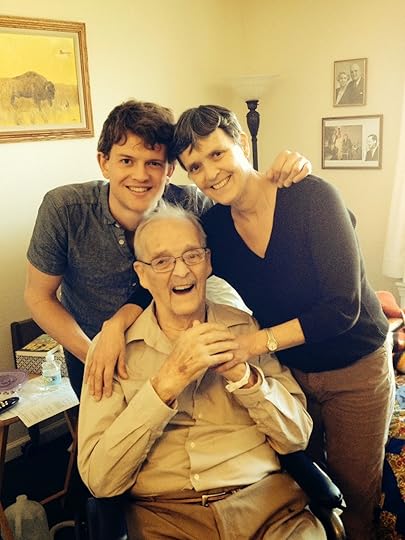Pam Withers's Blog, page 13
June 10, 2015
Where do writers get their ideas?

It's the No. 1 question we writers get, from both adults and children. My stock answer is "from my twisted imagination." In truth, each of my 17 books have grown from different seeds: from experiences in my life, from things I've read or that have happened to friends, and so on. Of course, it's not the idea that's important, but what you do with the idea: how you grow it.
Well, I've now completed 17 "inside stories" that reveal how my books were born -- how or why I grew them from vague ideas into completed books. Helpful, I hope, for both my readers/fans and writers out there in general.
Here's how to locate them.
1. Go to my home page (www.pamwithers.com)
2. Click on "Books" at the top right.
3. Note the list of my titles on the middle right, and click on the one that interests you.
4. Click on "Read the story behind the book" just below the book summary.
Which inside stories are most interesting? I'd say First Descent, Andreo's Race and (if you like horror stories, because every author has at least one) Paintball Island. Happy reading!
Published on June 10, 2015 12:56
June 4, 2015
Math & Science: Tips for Parents Wanting to Help Their Kids
 Stick a times-table or periodic table of the elements on the back of his notebook.Offer games that teach with several of the five senses (seeing, hearing, smelling, tasting, touching), as in sharing pizza or cake to learn fractions, or sorting silverware together.Tie learning to the real world, for instance, use money for math exercises, and relay the child-as-hero tsunami and electrical-wire stories above.Encourage him to use colored pencils to break up information.To reduce his anxiety, help him cut a window or slot in a square of cardboard so he can work on a page with only a portion of the text being visible.Encourage him to reword the question and create word problems for himself.For kids who transpose numbers (as in confuse 16 with 61), play card-search games.Find family games that reinforce science and math learning, and play them with him: Monopoly, Scattergories, Scrabble, Yahtzee, crossword puzzles, cribbage, Kings in the Corner, poker, and other card games. (Yes, solo computer games work too, but family games provide the extra key ingredient—time with you.)Quote sports statistics, and ask him to find information on his favorite sports.Cook and bake; he will use fractions without feeling intimidated as he reads recipes. Have him double his favorite recipes, then praise him for his effort.Use jingles: “Six and eight went on a date; they became forty-eight.”Play with him using money; have him make change.Have him help you figure out the best deal at the grocery store. (“Is it cheaper to buy a four-pack of pudding for $.99 or a twelve-pack for $2.79?”)Learn to use programs like Touch Point Math, a multisensory program designed to engage kids of all abilities and learning styles (www.touchmath.com).In a family meeting, ask kids to solve a math problem a variety of ways. Example: “How many different ways can we figure out the number of packages of hot dogs we’ll need for the party?” Then honor each child’s method of coming up with the answer. Require them each to solve it differently, and praise their effort. That way it is not just the answer but the process that will get the praise.Drill your kids on the basic skills while they are young. “Parents who think that calculators negate the need to learn multiplication tables are wrong,” says Bloomington, Minnesota, math teacher Nancy Johnson. “Kids who don’t memorize them don’t get the higher concepts. I’ve seen it again and again.”
Stick a times-table or periodic table of the elements on the back of his notebook.Offer games that teach with several of the five senses (seeing, hearing, smelling, tasting, touching), as in sharing pizza or cake to learn fractions, or sorting silverware together.Tie learning to the real world, for instance, use money for math exercises, and relay the child-as-hero tsunami and electrical-wire stories above.Encourage him to use colored pencils to break up information.To reduce his anxiety, help him cut a window or slot in a square of cardboard so he can work on a page with only a portion of the text being visible.Encourage him to reword the question and create word problems for himself.For kids who transpose numbers (as in confuse 16 with 61), play card-search games.Find family games that reinforce science and math learning, and play them with him: Monopoly, Scattergories, Scrabble, Yahtzee, crossword puzzles, cribbage, Kings in the Corner, poker, and other card games. (Yes, solo computer games work too, but family games provide the extra key ingredient—time with you.)Quote sports statistics, and ask him to find information on his favorite sports.Cook and bake; he will use fractions without feeling intimidated as he reads recipes. Have him double his favorite recipes, then praise him for his effort.Use jingles: “Six and eight went on a date; they became forty-eight.”Play with him using money; have him make change.Have him help you figure out the best deal at the grocery store. (“Is it cheaper to buy a four-pack of pudding for $.99 or a twelve-pack for $2.79?”)Learn to use programs like Touch Point Math, a multisensory program designed to engage kids of all abilities and learning styles (www.touchmath.com).In a family meeting, ask kids to solve a math problem a variety of ways. Example: “How many different ways can we figure out the number of packages of hot dogs we’ll need for the party?” Then honor each child’s method of coming up with the answer. Require them each to solve it differently, and praise their effort. That way it is not just the answer but the process that will get the praise.Drill your kids on the basic skills while they are young. “Parents who think that calculators negate the need to learn multiplication tables are wrong,” says Bloomington, Minnesota, math teacher Nancy Johnson. “Kids who don’t memorize them don’t get the higher concepts. I’ve seen it again and again.”Excerpted from Jump-Starting Boys: Help Your Reluctant Learner Find Success in School and Life, by Pam Withers and Cynthia Gill (Viva Editions). All references (footnotes) contained in the book.
http://www.amazon.com/Jump-Starting-Boys-Reluctant-Learner-Success-ebook/dp/B00BAHA0Y8/ref=sr_1_1?s=books&ie=UTF8&qid=1421455869&sr=1-1&keywords=jump+starting+boys
Published on June 04, 2015 15:35
June 1, 2015
Readers need a hero

I just read one of the best articles I've come across in a long time. It's about how kids who can't find a hero they can relate to in books are more inclined to become nonreaders, which sets them up to do poorly in education.
Although the piece focuses on aboriginals/natives in particular, the author points out that this lack of heroes is a problem facing schoolkids who are members of many immigrant groups in our multicultural world.
The article is written by David Bouchard, children's author, storyteller, literacy champion and former president of the Metis Nation of Greater Victoria, BC, Canada.
His article is is the Spring 2015 issue of Canadian Children's Booknews, which you can download for $4.95:
http://www.bookcentre.ca/store/products/canadian_childrens_book_news_spring_2015
He quotes Maria Montessori in saying that it takes three things to learn to read: time, a hero and books to which the reader can relate. Aboriginals (and immigrants) often lack books with heroes and material to which they can relate, he notes: "[They] can read and many do read, but all too many do not read for pleasure."
As for time, we're also not giving kids the flexible time they need: "Children will read when THEY are ready and not when we tell them to. Parents need not subject their children to early and overly aggressive testing that will taint the love of reading in their children."
Take these factors together and you've got roughly 70% of students on native reserves not completing high school, and more than 50% off-reserve dropping out before completing grade 12. "This is wrong and not acceptable," he says.
So concisely and persuasively written. Thanks, David Bouchard: http://www.davidbouchard.com/
Published on June 01, 2015 11:17
May 28, 2015
Boys' underachievement: weighing in
My last post, an excerpt from the Viva Editions book that I co-authored with my educator/therapist sister, Jump-Starting Boys (http://www.amazon.ca/Jump-Starting-Boys-Reluctant-Learner-Success-ebook/dp/B00BAHA0Y8/ref=sr_1_1?s=digital-text&ie=UTF8&qid=1432838986&sr=1-1&keywords=jump-starting+boys), was titled "Tackling Chronic Underachievement." I'm flattered that it prompted a reply from a longtime Canadian educator who has self-published a book (Rescuing our Underachieving Sons) on the same topic: Dr. James Brown.
While I'm pleased that the subject is being aired and discussed by lots of people from lots of different angles, I find the following comment to me from Dr. Brown too negative: "Parents really do not stand much of a chance; they are usually find themselves serving as the scapegoats for what is being done to their sons."
Au contraire! Parents can and must make themselves aware of the problems that add up to kids (esp. boys) underachieving, and as our book emphasizes, there is much they can and must do, not only as role models at home but as advocates in school and the community.
In any case, anyone wanting to hear Dr. Brown weighing in on the topic can check out this YouTube site:
https://www.youtube.com/watch?v=iS-QwfwJAhQ
It has some scary revelations about his own experiences in education.
While I'm pleased that the subject is being aired and discussed by lots of people from lots of different angles, I find the following comment to me from Dr. Brown too negative: "Parents really do not stand much of a chance; they are usually find themselves serving as the scapegoats for what is being done to their sons."
Au contraire! Parents can and must make themselves aware of the problems that add up to kids (esp. boys) underachieving, and as our book emphasizes, there is much they can and must do, not only as role models at home but as advocates in school and the community.
In any case, anyone wanting to hear Dr. Brown weighing in on the topic can check out this YouTube site:
https://www.youtube.com/watch?v=iS-QwfwJAhQ
It has some scary revelations about his own experiences in education.
Published on May 28, 2015 11:52
May 26, 2015
Tackling chronic underachievement
 When kids perform beneath their capabilities, parents typically try encouragement, lectures, rewards, threats, teacher meetings, private tutors, and maybe even testing for issues like ADHD. Some go so far as to let their child fail, hoping that will teach him a lesson. When none of these works and the problem stretches to a year or more, chances are he’s one of the fifteen percent of underachievers known as chronic underachievers.If so, it’s important to back off and dig deeper to understand the roots of the issue. Further attempts to help can actually make things worse. Chronic underachievement may stem from depression, anxiety, rebellion against authority (which applies to boys more than to girls), a high level of self-doubt, or even a desire to not stick out among classmates. Also, many kids (especially those with over-involved or under-involved parents) become masters at manipulating their parents, either because they’ve never learned how to do things for themselves or because they’re seeking approval or a more emotional relationship from an aloof parent. In this case, showing anger or frustration rewards their subconscious need for attention and dependency. Or perhaps they’re so busy trying to live up to parental ambitions that they don’t get around to forming self-motivation. Regardless, this variety of chronic underachiever becomes expert at transferring responsibility to others, and/or develops a debilitating dependency on others often masked by a charming and manipulative personality.Does he do homework only when you’re hovering? Does he continually blame shortcomings on the teacher, the class, or other factors? (“It’s not my fault.” “The teacher doesn’t like me.” “The class is boring.”) Does he lie? (“I did my homework at school.” “She didn’t tell us there was going to be a test.”)Here’s advice from Michael D. Whitley, Ph.D., author of Bright Minds, Poor Grades: Understanding and Motivating Your Underachieving Child: “The lies say to parents, ‘If you really want to know the truth about me, then you have to become so involved and entangled in my life that I will never have to be separated from you.’…If parents focus only on the facts their children lie about and never on the deeper psychology of lying, then parents simply feed the problem even more.”With chronic underachievers, rewards and punishments don’t work because they don’t teach self-motivation. Tutoring often exacerbates these kids’ dependency. And making them suffer the consequences doesn’t work because they only fall back on excuses.Instead, chronic underachievers must “learn to understand themselves, think out their own solutions to their problems, exercise self-discipline, and learn to feel positive feelings about schoolwork.”This may require professional counselling, or parents may be able to turn things around by working through the advice in Whitley’s book or Jane Nelsen’s Positive Discipline books. Most essential is that parents don’t fall into the common traps of shaming, humiliating, or rescuing their kids. Learn how to really encourage them, as we emphasize in Chapter Ten.Another resource is Why Bright Kids Get Poor Grades and What You Can Do About It: A Six-Step Program for Parents and Teachers by Dr. Sylvia Rimm, who says she reverses underachievement in roughly four out of five children in an average of six months. Here’s a sampling of Rimm’s advice: “Under no circumstances should your children expect to have you or your spouse sitting next to them regularly at homework time… If your children are accustomed to reminders, nagging, sympathy, and assistance, they have learned to get you to focus your attention on their dependence… Tough to watch them struggle, but don’t deprive them of this only way to develop self-confidence.”Excerpted from Jump-Starting Boys: Help Your Reluctant Learner Find Success in School and Life, by Pam Withers and Cynthia Gill (Viva Editions). All references (footnotes) contained in the book.http://www.amazon.com/Jump-Starting-Boys-Reluctant-Learner-Success-ebook/dp/B00BAHA0Y8/ref=sr_1_1?s=books&ie=UTF8&qid=1421455869&sr=1-1&keywords=jump+starting+boys
When kids perform beneath their capabilities, parents typically try encouragement, lectures, rewards, threats, teacher meetings, private tutors, and maybe even testing for issues like ADHD. Some go so far as to let their child fail, hoping that will teach him a lesson. When none of these works and the problem stretches to a year or more, chances are he’s one of the fifteen percent of underachievers known as chronic underachievers.If so, it’s important to back off and dig deeper to understand the roots of the issue. Further attempts to help can actually make things worse. Chronic underachievement may stem from depression, anxiety, rebellion against authority (which applies to boys more than to girls), a high level of self-doubt, or even a desire to not stick out among classmates. Also, many kids (especially those with over-involved or under-involved parents) become masters at manipulating their parents, either because they’ve never learned how to do things for themselves or because they’re seeking approval or a more emotional relationship from an aloof parent. In this case, showing anger or frustration rewards their subconscious need for attention and dependency. Or perhaps they’re so busy trying to live up to parental ambitions that they don’t get around to forming self-motivation. Regardless, this variety of chronic underachiever becomes expert at transferring responsibility to others, and/or develops a debilitating dependency on others often masked by a charming and manipulative personality.Does he do homework only when you’re hovering? Does he continually blame shortcomings on the teacher, the class, or other factors? (“It’s not my fault.” “The teacher doesn’t like me.” “The class is boring.”) Does he lie? (“I did my homework at school.” “She didn’t tell us there was going to be a test.”)Here’s advice from Michael D. Whitley, Ph.D., author of Bright Minds, Poor Grades: Understanding and Motivating Your Underachieving Child: “The lies say to parents, ‘If you really want to know the truth about me, then you have to become so involved and entangled in my life that I will never have to be separated from you.’…If parents focus only on the facts their children lie about and never on the deeper psychology of lying, then parents simply feed the problem even more.”With chronic underachievers, rewards and punishments don’t work because they don’t teach self-motivation. Tutoring often exacerbates these kids’ dependency. And making them suffer the consequences doesn’t work because they only fall back on excuses.Instead, chronic underachievers must “learn to understand themselves, think out their own solutions to their problems, exercise self-discipline, and learn to feel positive feelings about schoolwork.”This may require professional counselling, or parents may be able to turn things around by working through the advice in Whitley’s book or Jane Nelsen’s Positive Discipline books. Most essential is that parents don’t fall into the common traps of shaming, humiliating, or rescuing their kids. Learn how to really encourage them, as we emphasize in Chapter Ten.Another resource is Why Bright Kids Get Poor Grades and What You Can Do About It: A Six-Step Program for Parents and Teachers by Dr. Sylvia Rimm, who says she reverses underachievement in roughly four out of five children in an average of six months. Here’s a sampling of Rimm’s advice: “Under no circumstances should your children expect to have you or your spouse sitting next to them regularly at homework time… If your children are accustomed to reminders, nagging, sympathy, and assistance, they have learned to get you to focus your attention on their dependence… Tough to watch them struggle, but don’t deprive them of this only way to develop self-confidence.”Excerpted from Jump-Starting Boys: Help Your Reluctant Learner Find Success in School and Life, by Pam Withers and Cynthia Gill (Viva Editions). All references (footnotes) contained in the book.http://www.amazon.com/Jump-Starting-Boys-Reluctant-Learner-Success-ebook/dp/B00BAHA0Y8/ref=sr_1_1?s=books&ie=UTF8&qid=1421455869&sr=1-1&keywords=jump+starting+boys
Published on May 26, 2015 11:04
May 19, 2015
Writers' retreat
 This past weekend I coordinated and participated in a children’s/young-adult writer’s retreat led by award-winning author Kit Pearson on Mayne Island, British Columbia. It was inspirational and fun!Top row, L to R: Penny Draper, Kit Pearson, Sheri Radford, Cynthia Heinrichs, Lois Peterson, Maggie deVries, P-j Sarah Collins, Sara CassidyLower row: Marion Crook, Pam Withers, Silvana Goldemberg
This past weekend I coordinated and participated in a children’s/young-adult writer’s retreat led by award-winning author Kit Pearson on Mayne Island, British Columbia. It was inspirational and fun!Top row, L to R: Penny Draper, Kit Pearson, Sheri Radford, Cynthia Heinrichs, Lois Peterson, Maggie deVries, P-j Sarah Collins, Sara CassidyLower row: Marion Crook, Pam Withers, Silvana Goldemberg
Published on May 19, 2015 15:32
May 14, 2015
The car trip that launched a book
 Pam Withers with (to right) her older sister and co-author Cynthia GillThe inside story of writing Jump-Starting Boys: Help Your Reluctant Learner Find Success in School and Life (Viva Editions 2013)
Pam Withers with (to right) her older sister and co-author Cynthia GillThe inside story of writing Jump-Starting Boys: Help Your Reluctant Learner Find Success in School and Life (Viva Editions 2013)Everyone knows that boys are falling behind in education. Largely left out of the discussion are parents of boys, who are most aware that their bright, eager sons hit an invisible wall somewhere near fourth grade, after which they become disengaged, discouraged, and disaffected. There are dozens of books on underachieving boys, but most parents brave enough to lift one off the shelf are instantly intimidated by the footnotes, graphs, case studies, and academic-speak addressed almost entirely to educators. What about the average guilt-ridden, frustrated mother or father of an underachieving boy? Jump-Starting Boys is the first book on the market that empowers parents, helping them reclaim the duties and rewards of raising their children and navigate the influences of school and media. Filled with reassurance and support, the authors turn fear and guilt into can-do confidence. Through easy tips and action list sidebars, this is the most practical, readable book on the topic.
From Amazon:
http://www.amazon.com/Jump-Starting-Boys-Reluctant-Learner-Success/dp/1936740397/ref=sr_1_1?s=books&ie=UTF8&qid=1431627081&sr=1-1&keywords=jump-starting+boys
When I first started writing adventure books for teen and pre-teen boys, librarians used to comment to me, “These are perfect for reluctant readers!”
The first time this happened, I responded, “What are reluctant readers?”
That launched me on an investigation that became a passion. I immersed myself in reading on the topic, and started gathering statistics and stories for presentations. The trouble is, most of the books on the topic are written for academics rather than parents and mentors. They can make parents feel even less empowered and frustrated than they already do.
A few years later, my older sister Cynthia and I found ourselves riding in a car together for six hours while en route to a family funeral. Ever tried to find conversation good for six hours with a sibling with whom you aren’t particularly close? (Cynthia is two years older, and all my life I saw her as prettier, smarter, bossy, more popular and confident; I looked up to her and was intimidated by her!)
Cynthia (who lives in Minneapolis, Minnesota) is a long-time educator who went back to school to become a therapist; she now works with at-risk teens and their families. http://www.cynthiagill.info/
I certainly admire that about her. Anyway, we chatted about raising boys (she has three; I have one), and the challenge of turning them out as happy and successful citizens. We also both have a mutual love for reading, planted in us by our parents who read to us much as children. So we spent lots of time talking about the importance of getting boys to read. (Boys form the majority of reluctant readers.)
By the end of the six hours, we said (naively!), “Let’s write a book together about that!”
It was supposed to be an eight-month project, but it turned into a two-year labor of love. Our biggest fear was that we wouldn’t be speaking to each other by the end of it, but happily, it actually brought us much closer.
Viva Editions of California http://www.vivaeditions.com/index.php was the publisher who took us on and encouraged us all the way through. They were great to work with, and pulled out all the stops for publicizing the book.
To us, and I think to Viva Editions, it’s more than just a book. It’s a mission to help reluctant reader and under-achieving boys. We want parents and mentors to know that they have the power and responsibility to make a difference.
Feedback we’ve received is very positive, and we hope Jump-Starting Boys continues to contribute to the parenting, education and mentoring of boys. They deserve the best!
Published on May 14, 2015 11:24
May 6, 2015
Kindness abroad
 Last week a friend and I went to a Spanish-speaking country for a week of relaxation and Spanish practice. We hired a tutor there, Carlos, and enjoyed several hours a day with him; he was fun and open, a natural teacher, a lively and trust-inspiring personality. One day he offered to show us his village after class, a 20-minute bus ride away. Off we went. As we arrived, we noticed a large fire burning in the not-so-far distance, like an oil tanker on fire or something. I was about to inquire about it when I realized there was no reason Carlos would know anything more than us.He crossed a street at one point to have a long, fast-paced conversation with a woman. We figured he knew her, or was asking directions to somewhere. Minutes later, he urged us to come view the local church because it was a tourist highlight.On arriving at the church, he immediately dropped to his knees and began praying. We sat quietly and respectfully, looking about. The church seemed quite full, and it was indeed very pretty. When Carlos stood, he encouraged us to take photos and we spent a bit more time there. Then he took us through the markets and put us on our bus, which delivered us back to our hotel twenty minutes later.Only after we arrived did we learn that the hotel was advising no one to leave the premises that afternoon, because gangs with masks and machine guns were riding around in pickups bombing gas stations and businesses (including the bank across from our hotel, where we’d been using the cash machine). They also shot a military helicopter out of the sky, killing the police officers inside it.Later, Carlos told us he had learned from the lady across the street what was occurring, and ushered us to the church for safety. Then he had prayed for us, his community and all nearby communities. But he had not wanted us to know or to worry, as the gangs were not targeting tourists.I am not revealing the location because the district doesn’t need the negative publicity. But my friend and I found Carlos’s kindness heart-warming, and a story worth sharing.
Last week a friend and I went to a Spanish-speaking country for a week of relaxation and Spanish practice. We hired a tutor there, Carlos, and enjoyed several hours a day with him; he was fun and open, a natural teacher, a lively and trust-inspiring personality. One day he offered to show us his village after class, a 20-minute bus ride away. Off we went. As we arrived, we noticed a large fire burning in the not-so-far distance, like an oil tanker on fire or something. I was about to inquire about it when I realized there was no reason Carlos would know anything more than us.He crossed a street at one point to have a long, fast-paced conversation with a woman. We figured he knew her, or was asking directions to somewhere. Minutes later, he urged us to come view the local church because it was a tourist highlight.On arriving at the church, he immediately dropped to his knees and began praying. We sat quietly and respectfully, looking about. The church seemed quite full, and it was indeed very pretty. When Carlos stood, he encouraged us to take photos and we spent a bit more time there. Then he took us through the markets and put us on our bus, which delivered us back to our hotel twenty minutes later.Only after we arrived did we learn that the hotel was advising no one to leave the premises that afternoon, because gangs with masks and machine guns were riding around in pickups bombing gas stations and businesses (including the bank across from our hotel, where we’d been using the cash machine). They also shot a military helicopter out of the sky, killing the police officers inside it.Later, Carlos told us he had learned from the lady across the street what was occurring, and ushered us to the church for safety. Then he had prayed for us, his community and all nearby communities. But he had not wanted us to know or to worry, as the gangs were not targeting tourists.I am not revealing the location because the district doesn’t need the negative publicity. But my friend and I found Carlos’s kindness heart-warming, and a story worth sharing.
Published on May 06, 2015 11:04
May 4, 2015
Importance of getting kids (esp. boys) comfortable with reading

A key reason boys struggle more than girls in school and life: Adults fail to help them get comfortable with reading at a young age. Here's an excerpt from my book, Jump-Starting Boys.
Boys read less than girls do.Parents read to boys for shorter periods of time than they read to girls.Teen girls read almost twice as much as boys on a per-hour basis.Some thirty-seven percent of male college freshmen, and only twenty-three percent of female college freshmen, say they spend no time reading for pleasure.
More boys than girls struggle with reading and writing.The average eleventh-grade American boy writes at the same level as the average eighth-grade girl.Boys start school with a considerable verbal and psychosocial developmental lag (up to eighteen months), behind girls. They often do not catch up until into their late teens—if then.The majority of reluctant readers are boys.While seventy percent of children learn to read with no special support, most of the rest—those with problems—are male, nonwhite, and economically deprived.Boys get most of the D’s and F’s in school grades.Adolescent males are significantly more likely than adolescent females to be left back a grade.Boys have a harder time finding books on their own.Adolescent girls outscore adolescent boys in reading and writing—the gender gap being equivalent to a year and a half of school. In other words, the average high school freshman girl is reading as well as the average high school junior boy.Boys are four times more likely than girls to be in learning disability programs.The gender gap in literacy is worldwide. Even in Finland, which boasts the top-ranked students in literacy, girls scored much higher than boys.Adolescent males drop out of high school at four times the rate of adolescent females (this includes females who drop out to have babies).
Boys have more attitude and are less active in the school community.Males are more likely to view schooling in general (and specifically literacy) as artificial, even unmanly.Ninety percent of adolescent discipline problems in schools involve males, as do most expulsions and suspensions.Boys are the primary victims of violence in schools, and comprise the majority of dead, injured, mentally ill, and substance-abusing adolescents.The majority of salutatorians and valedictorians now are female. Adolescent females also dominate school clubs, yearbooks, and student government.Boys are four times more likely to be referred to a school psychologist.
There’s a direct link between comfort with reading and attitude.“Once they begin to fall behind, they act out because they are bored or disengaged, and a really difficult downward spiral results.”“Poor reading among boys leads to antisocial behavior.”Low literacy is related to crime, poverty, and unemployment.There’s a direct link between comfort with reading and academic achievement.The most important predictor of academic success is the amount of time children spend reading books; it is even more important than economic or social status.“The act of reading or being read to develops the mind and increases intelligence.”“Kids who stop reading start to fall behind their classmates.They lose ground in vocabulary, in comprehension, in advanced thinking skills, even in the ability to write.”“The achievement gap between boys and girls is driven primarily by performance differences in literacy.”Teaching boys science, math, or social studies poses problems if they have difficulty reading the textbook and won’t admit it.
There’s a direct link between academic achievement and life achievement.With the decline of high-paying work in traditional male occupations, such as manufacturing, and the increase of high-paying work in occupations requiring informational processing skills, men without a college education have been left behind.A college degree is linked to higher earnings, increased civic participation, marriage and family stability, lower rates of incarceration, and national economic competitiveness in a global environment.“A college degree today is as necessary to success as a high school diploma was a few decades ago.”Those with a bachelor’s degree earn upwards of forty percent more than high school graduates, a gap slowly but steadily widening.Eighty percent of high school dropouts are male.Eighty percent of convicted felons are high school dropouts.Sixty-eight percent of the people incarcerated in federal penitentiaries have limited literacy skills.Sixty-three percent of Canadian social assistance recipients have not completed secondary school.
Boys’ enrolment in institutes of higher education is decreasing.In the U.S., women earn sixty-two percent of all associates’ degrees, fifty-seven percent of all bachelors’ degrees, and sixty percent of all masters’ degrees.Boys finish their education less frequently (high school graduation rate of only sixty-five percent), they finish high school with lower average grades (girls average 3.10 GPA, boys average 2.90 GPA), and fewer go to college. Since 1981, more women than men have been enrolling in college.Between the years 1990 and 2009, the male undergraduate enrolment dropped from forty-five percent to forty-three percent in the U.S.
“Something is not working for boys, but there is little to no direct research on gender and literacy, and not much in the way of support for boys’ literacy,” Jon Scieszka declares on his Guys Read website (www.guysread.com).We like to think that’s changing, but not fast enough, and certainly insufficiently in terms of information parents receive.Excerpted from Jump-Starting Boys: Help Your Reluctant Learner Find Success in School and Life, by Pam Withers and Cynthia Gill (Viva Editions). All references (footnotes) contained in the book.http://www.amazon.com/Jump-Starting-Boys-Reluctant-Learner-Success-ebook/dp/B00BAHA0Y8/ref=sr_1_1?s=books&ie=UTF8&qid=1421455869&sr=1-1&keywords=jump+starting+boys
Published on May 04, 2015 12:42
April 25, 2015
Family reunion


I've spent the past week in Minneapolis with my dad (88 years old) and my older sister Cynthia Gill. While visiting Dad, I opened Andreo's Race to the page that dedicates the book to him, and held it up to him as he lay in bed recovering from a fall. What a great smile spread across his face, and my son Jeremy (who joined us for a visit to his grandpa and aunt) read it to him for a while.
For Cynthia and me, of course, it was a reunion during which we recounted the fun and stress of co-writing Jump-Starting Boys. While in Minneapolis, Jeremy and I also visited two of Cynthia's sons and their kids. A fun family reunion and I still feel the warmth of our many hugs!
Published on April 25, 2015 21:01



